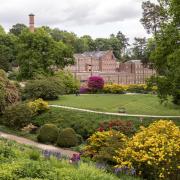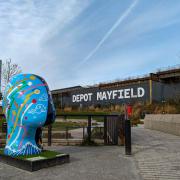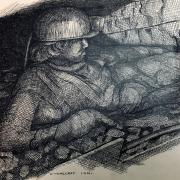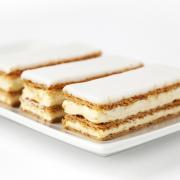Rebecca Broad is a Middlewich-based ceramicist who is rapidly developing a reputation for her glorious, nature inspired pieces, writes Kate Houghton

‘The first time I touched clay I just knew,’ Rebecca tells me, when I ask what drew her to ceramics. For most of us this first time would have taken place in our school days, perhaps in our later years a primary school and most certainly at secondary school. Who can forget the cold, wet, slippery slide of fresh clay though the fingers, as attempts are made (with varying degrees of success) to create something beautiful, and ending up with an ash-tray? For Rebecca her first time was much, much, later, as she started her Art Foundation course at Mid Cheshire College.
‘I had set out with a dream of studying Fine Art,’ she says, ‘specifically drawing. My earliest memories are all of drawing. But the course was, of course, very broad and I was introduced to working with clay – and have never stopped.’
Rebecca is lovely; full of energy and joy, she is clearly truly fulfilled by her work and over the moon that it has caught the attention of art collectors and lovers of all things beautiful so quickly after setting up a professional studio.
Making art your career requires more than talent; it needs dedication, hard-work, a willingness to take chances and a positive and open personality. Rebecca’s talent goes without saying and her desire to succeed, allied with a warm and happy personality have brought her the rest of the way.
‘I started my degree studies in London,’ she tells me, ‘at the University of the Arts. I joined a pure ceramics course, but they closed it down after one year. I searched around and was able to transfer into the Applied Arts degree course in Preston. [Where she achieved a First Class honours degree]
‘While I was at mid-Cheshire I learned about paper clay, where paper pulp is mixed with clay to give it a different degree of malleability. I love it because it means I can still work the clay or porcelain when it’s drying out. When you fire it the paper burns out. The risk is of course that by burning out the paper you make the piece very fragile. While at Preston I worked to refine my approach to use a minimal amount of paper. This means that when it’s burned out in the kiln the porcelain is still very strong, but I have the shapes I want.’
Rebecca’s work seems terrifyingly delicate, but when you hold it you can feel that it’s actually very robust. It’s an effort of will to lift them for a closer look however – your eyes are telling you that it’s wafer thin and sure to crumble, yet touch and feel it and you understand that this is not the case – a true dichotomy for the senses.
‘I have a sign on my stall when I attend craft markets that says: “Please pick me up!”’ laughs Rebecca. ‘I would never make anything people couldn’t touch and handle! My work is tactile, as much for the sense of touch as of sight.’
Rebecca’s work is inspired by her love of flowers.
‘I’ve always been obsessed by the lifecycle of flowers. They look so fragile, but obviously they’re not and can hold their form even in decay. When you look at one type of flower, they all look the same – but when you look more closely, they’re all different.’
Exactly like her own work, in fact.
Rebecca works with white porcelain and black clay, both sourced from Stoke-on-Trent. At the moment her pieces are one colour or the other, though she has done some experimenting with mixing the two and may develop this further in the future. He work ranges from tiny, exquisitely formed pendants set on fine gold and silver chains to ethereal narrow vases to stunning, hold-the-gaze curvy honeycomb wall art and bowls to extraordinary tubular, coral-like explosions. I love it all and could have stripped her studio bare!
Rebecca set up her studio in 2014, blessed to have been offered a space in the corner of her father’s motor repairs workshop, surrounded by sportscars in need of TLC. This allowed her to save and purchase her own kiln, used to complete her beautiful work. Its small size has restricted her a little to date, however, a restriction recently set to rights by a chance meeting with her old tutor from Mid Cheshire College.
‘We met at the opening of a new arts centre in Middlewich,’ she says. ‘The Boatyard Art Space’ will allow eight local artists to exhibit their work, including me. Longer term it will provide studio space and offer courses. When we met he told me that I was one of those students with an instinctive feel for ceramics that couldn’t be taught. He asked if I would like to take on an Artist in Residence role at the College, which will entail working with students and demonstrations of how I work. He also offered me use of the kilns there, which will mean I can make much larger pieces, something I’m very excited about.’
These larger pieces will go on display at the Great Northern Contemporary Craft Fair (GNCCF) held in Manchester this month, an event Rebecca had on her five-year ‘to achieve’ list, but has happened for her very quickly.
Rebecca says: ‘I volunteered there last year and it was amazing. It’s a very big deal in the art world, with artists and art lovers and gallery owners all coming together. I applied to attend this year and when I got the email to tell me I’d won a place I cried!’
Attendance at events of this nature are vital to a new young artist’s success, leading to commissions from private collectors, interior designers, homeowners and galleries. Her first major event was this summer, when she attended the inaugural Simply Cheshire event at Arley Hall.
‘It was amazing. It’s just really humbling that people not only admire what I have created, but want to buy it too. I never want to lose that feeling.’
I suspect it’s a feeling she’ll have to get used to, but will hopefully always cherish. w



























